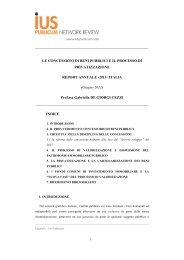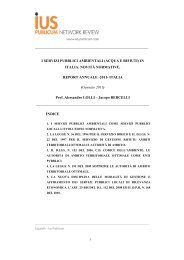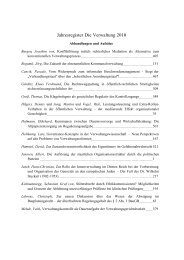Athanasios Gromitsaris, Expropriations, Takings - ius-publicum
Athanasios Gromitsaris, Expropriations, Takings - ius-publicum
Athanasios Gromitsaris, Expropriations, Takings - ius-publicum
You also want an ePaper? Increase the reach of your titles
YUMPU automatically turns print PDFs into web optimized ePapers that Google loves.
_____________________________________________________________<br />
ally still as tax. Beyond this unusual and extreme case two seminal rulings deal with the<br />
question of defining a constitutional limit to taxation. 70<br />
The Federal Constitutional Court introduced in 1995 a fifty-percent rule that was<br />
finally abandoned in 2006 by the Court itself. 71 According to this rule which was based on<br />
Article 14.2 of the Basic Law dealing with the social obligation imposed by constitutionally<br />
protected property, the tax load on assets should be limited to 50% of the yield on those as-<br />
sets. 72 The rule was understood as a defence of private property and a means of warding off<br />
excessive taxation by actually defining the upper limit of taxation and, at the same token,<br />
the minimum of subsistence and material welfare of an individual person that is allowed to<br />
be kept unencumbered by taxes. However, the fifty-percent rule could not be established as<br />
a general principle of tax law, let alone of all forms of public charges. In its 2006 ruling the<br />
Federal Constitutional Court abandoned the effort to find any a priori-standard for taxes<br />
and to derive any fixed limit of taxation from article 14.2 of the Basic Law. 73 By contrast, it<br />
held that limitations on the tax legislature result from the application of the proportionality-<br />
test (reasonableness). The Court adjusted the application of the principle of proportionality<br />
to taxation. According to the principle of proportionality, any state interference with the<br />
right to property must serve a legitimate purpose, must be the least intrusive means to serve<br />
this purpose, and must have a reasonable and adequate impact on the legal position of the<br />
70 See for ex. the reasoning of the claimant in BVerfG, 2 BvR 1387/04 vom 24.11.2009, Absatz-Nr. (1 - 98),<br />
http://www.bverfg.de/entscheidungen/rs20091124_2bvr138704.html; and further BVerfG, 1 BvR 1924/07 vom<br />
7.4.2008, Absatz-Nr. (1 - 37), at para 35, http://www.bverfg.de/entscheidungen/rk20080407_1bvr192407.html.<br />
71 BVerfG, 2 BvR 2194/99 vom 18.1.2006, Absatz-Nr. (1 - 50),<br />
http://www.bverfg.de/entscheidungen/rs20060118_2bvr219499.html.<br />
72 Andreas von Arnauld/Klaus W. Zimmermann, Regulating government (´s share): The fifty-percent rule of the<br />
Federal Constitutional Court in Germany, Working paper series, No. 100, Helmut Schmidt University Hamburg,<br />
März 2010, 1-29.<br />
73 BVerfGE 115, 97 (114); BVerfGE 82, 159 (190).<br />
______________________________________________________________________________<br />
Copyleft – Ius Publicum<br />
38





